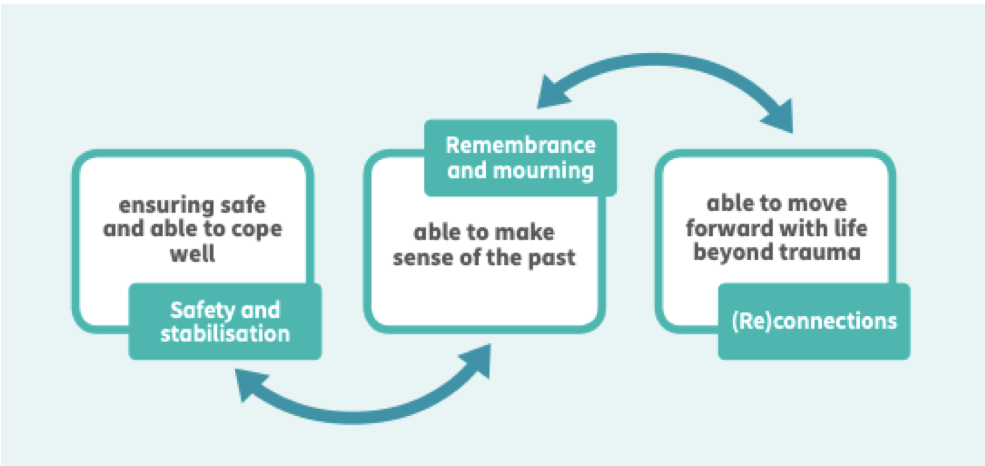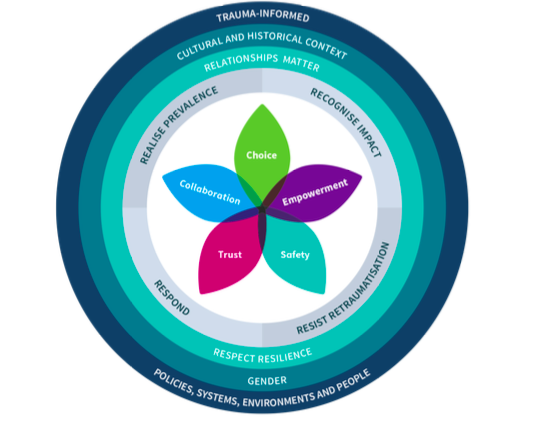Key Principles and Practice
A sound understanding of trauma and its far-reaching implications is crucial to providing accessible, effective and quality support for adult survivors of childhood abuse.
In this section we discuss the key principles of trauma-informed practice and the Herman model of recovery.
a. Trauma-Informed Practice
Key Definitions
The National Trauma Informed Practice Toolkit is a helpful resource to guide your thinking and approach. The following definitions come from this toolkit.
How to develop trauma informed practice:
Development of genuine trauma-informed practice requires moving beyond traditional models of service delivery and re-evaluating your organisational practices and policies through a trauma-focused lens.
At the heart of that system are the five key principles of trauma-informed practice
- Safety
Your organisation ensures the physical and emotional safety of clients and staff. This includes reasonable freedom from threat or harm, and attempts to prevent further re-traumatisation. - Trustworthiness
Your organisation has transparent policies and procedures, with the objective of building trust among staff, clients and the wider community. - Choice
Clients and staff have meaningful choice and a voice in the decision-making process of your organisation and its services. - Collaboration
Your organisation recognises the value of staff and clients' experience in overcoming challenges and improving the system as a whole. - Empowerment
Your organisation shares power and gives clients and staff a strong voice in decision-making, at both individual and organisational levels.
These values should influence how activities and programmes aimed at improving wellbeing and addressing trauma for adult survivors of childhood abuse are delivered.
These five principles are at the heart of developing a fully trauma-informed system as illustrated in the image below.
Where can you find out more?
A trauma-informed practice toolkit has been developed as part of the National Trauma Training Programme, to support all sectors of the workforce to plan and develop trauma-informed services. The toolkit was developed from the voices of trauma survivors, staff and leaders in the field, and defines the steps organisations can take and the barriers that might get in their way.
b. Herman’s phased approach to recovery
Understanding of trauma, intervention and recovery is constantly evolving. However, experts broadly agree that interventions for the effects of trauma should include three phases as established by Judith Herman.

Source: Google
Not every survivor will need every phase. Survivors can move in both directions through the phases and spend differing amounts of time in different phases, depending on their current life circumstances and recovery pathway.
Phase I: Safety and Stabilisation
Phase I of treatment/support involves a period of safety, stabilisation and resource building to maintain survivor safety. The aim of this phase is to help a survivor to stay within their ‘Window of Tolerance’
The Safety and Stabilisation phase include psycho-education on trauma and disassociation, and provides survivors with skills to help manage their trauma reaction. For example: different grounding and breathing techniques.
This paper from 2019 covers safety and stabilisation techniques in complex trauma.
Phase II : Remembrance and mourning
In Phase II, survivors may access trauma-processing approaches, which help them make sense of what happened in the past and process ‘stuck’ memories. This may include talking about what happened to them, or working specifically with their thoughts, feelings, physical symptoms and behaviours. Specific trauma-processing techniques, such as Eye Movement Desensitization and Reprocessing [EMDR], can help reduce the distress linked to the memory of past trauma.
Phase III: (Re)connections
In Phase III survivors are working to move forward with their life and make [re]connections. This may be getting in contact with - or gaining further support from - friends or family, engaging with personal or social activities they enjoyed in the past, or working.
Previous
Section 1 Introduction
Next
Shared Language and terminology

